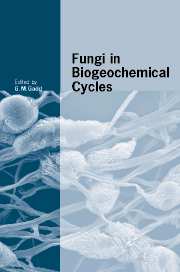Book contents
- Frontmatter
- Contents
- List of Contributors
- Preface
- 1 Geomicrobiology: relative roles of bacteria and fungi as geomicrobial agents
- 2 Integrated nutrient cycles in boreal forest ecosystems – the role of mycorrhizal fungi
- 3 Fungal roles in transport processes in soils
- 4 Water dynamics of mycorrhizas in arid soils
- 5 Integrating ectomycorrhizal fungi into quantitative frameworks of forest carbon and nitrogen cycling
- 6 Role of arbuscular mycorrhizal fungi in carbon and nutrient cycling in grassland
- 7 The role of wood decay fungi in the carbon and nitrogen dynamics of the forest floor
- 8 Relative roles of bacteria and fungi in polycyclic aromatic hydrocarbon biodegradation and bioremediation of contaminated soils
- 9 Biodegradation and biodeterioration of man-made polymeric materials
- 10 Fungal dissolution and transformation of minerals: significance for nutrient and metal mobility
- 11 Fungal activities in subaerial rock-inhabiting microbial communities
- 12 The oxalate–carbonate pathway in soil carbon storage: the role of fungi and oxalotrophic bacteria
- 13 Mineral tunnelling by fungi
- 14 Mineral dissolution by ectomycorrhizal fungi
- 15 Lichen biogeochemistry
- 16 Fungi in subterranean environments
- 17 The role of fungi in carbon and nitrogen cycles in freshwater ecosystems
- 18 Biogeochemical roles of fungi in marine and estuarine habitats
- Index
- References
2 - Integrated nutrient cycles in boreal forest ecosystems – the role of mycorrhizal fungi
Published online by Cambridge University Press: 10 December 2009
- Frontmatter
- Contents
- List of Contributors
- Preface
- 1 Geomicrobiology: relative roles of bacteria and fungi as geomicrobial agents
- 2 Integrated nutrient cycles in boreal forest ecosystems – the role of mycorrhizal fungi
- 3 Fungal roles in transport processes in soils
- 4 Water dynamics of mycorrhizas in arid soils
- 5 Integrating ectomycorrhizal fungi into quantitative frameworks of forest carbon and nitrogen cycling
- 6 Role of arbuscular mycorrhizal fungi in carbon and nutrient cycling in grassland
- 7 The role of wood decay fungi in the carbon and nitrogen dynamics of the forest floor
- 8 Relative roles of bacteria and fungi in polycyclic aromatic hydrocarbon biodegradation and bioremediation of contaminated soils
- 9 Biodegradation and biodeterioration of man-made polymeric materials
- 10 Fungal dissolution and transformation of minerals: significance for nutrient and metal mobility
- 11 Fungal activities in subaerial rock-inhabiting microbial communities
- 12 The oxalate–carbonate pathway in soil carbon storage: the role of fungi and oxalotrophic bacteria
- 13 Mineral tunnelling by fungi
- 14 Mineral dissolution by ectomycorrhizal fungi
- 15 Lichen biogeochemistry
- 16 Fungi in subterranean environments
- 17 The role of fungi in carbon and nitrogen cycles in freshwater ecosystems
- 18 Biogeochemical roles of fungi in marine and estuarine habitats
- Index
- References
Summary
Introduction
Mycorrhizal fungi play a central role in biogeochemical cycles since they obtain carbon from their photosynthetic plant hosts and allocate this via their mycelia to the soil ecosystem. The mycelia interact with a range of organic and inorganic substrates, as well as with different organisms such as bacteria, fungi, soil micro- and meso-fauna and the roots of secondary hosts or non-host plants. Some of the carbon allocated to the mycelium is used to make compounds such as enzymes, organic acids, siderophores or antibiotics, which influence biotic or abiotic substrates through processes such as decomposition, weathering or antibiosis. Organic and inorganic nutrients mobilized from these substrates can be taken up by the mycorrhizal mycelia and translocated to their plant hosts, influencing plant growth, community structure and vegetation dynamics. Ultimately these changes have further impacts on biogeochemical cycles. Different types of mycorrhizal symbiosis have evolved as adaptations to different suites of edaphic parameters, resulting in the characteristic vegetation types that dominate different terrestrial biomes. Other chapters in this book consider specific contributions of ectomycorrhizal fungi to mineral dissolution (see Wallander, Chapter 14, this volume), carbon and nitrogen cycling (see Hobbie & Wallander, Chapter 5, this volume) and mineral tunnelling (see Smits, Chapter 13, this volume). In this chapter we concentrate on how these activities are integrated and on ways in which ectomycorrhizal hyphae may interact with other microorganisms to influence biogeochemical cycles.
- Type
- Chapter
- Information
- Fungi in Biogeochemical Cycles , pp. 28 - 50Publisher: Cambridge University PressPrint publication year: 2006
References
- 14
- Cited by



